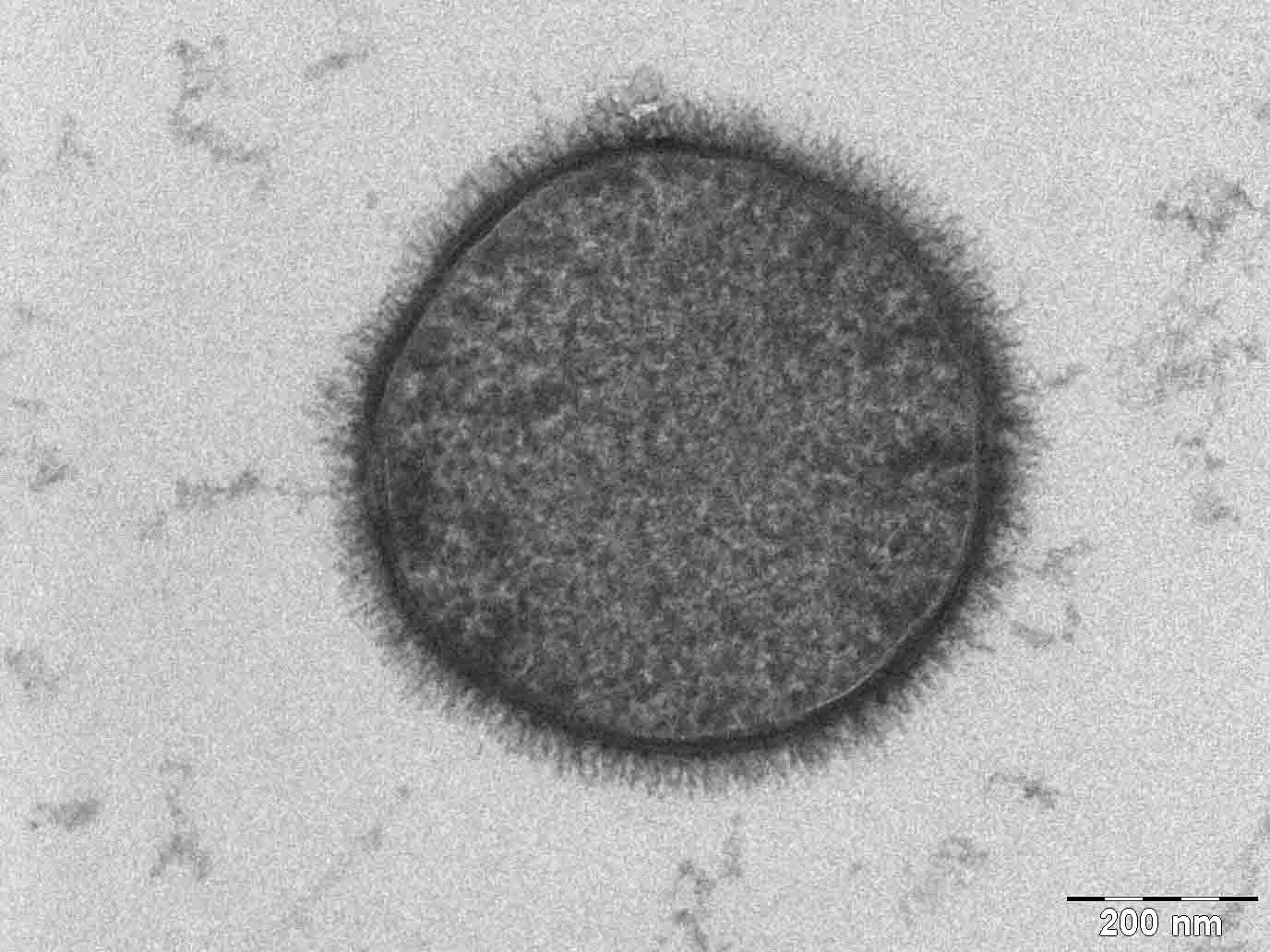- Bacillus subtilis
Taxobox

image_caption = TEMmicrograph of a "B. subtilis" cell in cross-section (scale bar = 200 nm).
regnum =Bacteria
phylum =Firmicutes
classis =Bacilli
ordo =Bacillales
familia =Bacillaceae
genus = "Bacillus "
species = "B. subtilis"
binomial = "Bacillus subtilis"
binomial_authority = (Ehrenberg 1835)
Cohn 1872"Bacillus subtilis" is a
Gram-positive ,catalase -positivebacterium commonly found in soil.cite book | author = Madigan M; Martinko J (editors). | title = Brock Biology of Microorganisms | edition = 11th ed. | publisher = Prentice Hall | year = 2005|id = ISBN 0-13-144329-1 ] A member of thegenus "Bacillus ", "B. subtilis" has the ability to form a tough, protectiveendospore , allowing the organism to tolerate extreme environmental conditions. Unlike several other well-known species, "B. subtilis" has historically been classified as an obligate aerobe, though recent research has demonstrated that this is not strictly correct.cite journal | author=Nakano MM, Zuber P | title=Anaerobic growth of a "strict aerobe" ("Bacillus subtilis") | journal=Annu Rev Microbiol | year=1998 | pages=165–90 | volume=52 | pmid=9891797|doi=10.1146/annurev.micro.52.1.165 ]It has also been called Hay bacillus or Grass bacillus. It is bacillus because the bacterium is rod shaped or bacilli shaped.
Pathogenesis
"B. subtilis" is not considered a human pathogen; it may contaminate food but rarely causes
food poisoning .cite book | author = Ryan KJ, Ray CG (editors) | title = Sherris Medical Microbiology | edition = 4th ed. | publisher = McGraw Hill | year = 2004|isbn = 0-8385-8529-9 ] "B. subtilis" produces the proteolytic enzymesubtilisin . "B. subtilis" spores can survive the extreme heating that is often used to cook food, and it is responsible for causing "ropiness" — a sticky, stringy consistency caused by bacterial production of long-chainpolysaccharide s — in spoiled bread dough."'Reproduction
"B. subtilis" can divide asymmetrically, producing an endospore that is resistant to environmental factors such as heat, acid, and salt, and which can persist in the environment for long periods of time. The endospore is formed at times of nutritional stress, allowing the organism to persist in the environment until conditions become favorable. Prior to the decision to produce the spore the bacterium might become motile, through the production of flagella, and also take up DNA from the environment.
Replication of the chromosome
"Bacillus subtilis" duplicates its single circular
chromosome by initiatingDNA replication at a single locus, the origin ("oriC"). Replication proceeds bidirectionally and two replication forks progress in the clockwise and counterclockwise directions along the chromosome halves. Chromosome replication is completed when the forks reach the terminus region, which is positioned opposite to the origin on the chromosome map, and contains several short DNA sequences ("Ter" sites) that promote replication arrest. Specific proteins mediate all the steps in DNA replication. The comparison between the sets of proteins involved in chromosomal DNA replication in "B. subtilis" and in "Escherichia coli " reveals both similarities and differences. Although the basic components promoting initiation, elongation, and termination of replication are well conserved, some important differences can be found (such as one bacterium missing proteins essential in the other). These differences underline the diversity in the mechanisms and strategies that various bacterial species have adopted to carry out the duplication of their genomes.cite book |url=http://www.horizonpress.com/bac |author=Noirot P|chapter=Replication of the Bacillus subtilis chromosome | title = Bacillus: Cellular and Molecular Biology "(Graumann P, ed.)| publisher = Caister Academic Press | year = 2007 | isbn = 978-1-904455-12-7 ]"B. subtilis" as a model organism
"B. subtilis" has proven highly amenable to
genetic manipulation , and has therefore become widely adopted as amodel organism for laboratory studies, especially ofsporulation , which is a simplified example ofcellular differentiation . It is also heavilyflagellate d, which gives "B.subtilis" the ability to move quite quickly. In terms of popularity as a laboratory model organism "B. subtilis" is often used as the Gram-positive equivalent of "Escherichia coli ", an extensively studiedGram-negative rod.Uses
"B. subtilis" is used as a
soil inoculant inhorticulture andagriculture . "B. subtilis" has been used for a biowarfare duringProject SHAD (aka "Project 112"). [http://www1.va.gov/shad/] "B. subtilis" hazard status is under dispute. [http://www.gulfwarvets.com/story3.htm]Enzymes produced by "B. subtilis" and "B. licheniformis" are widely used as additives in
laundry detergent s.Its other uses include the following:
*a model organism for laboratory studies
*a strain of "B. subtilis" formerly known as "Bacillus natto" is used in the commercial production of the Japanese delicacynatto as well as the similar Korean foodcheonggukjang
*"B. subtilis" strain QST 713 (marketed as QST 713 or Serenade) has a natural fungicidal activity, and is employed as a biological control agent
*can convert explosives into harmless compounds of nitrogen, carbon dioxide, and water
*plays a role in safe radionuclide waste [e.g. Thorium (IV) and Plutonium (IV)] disposal with the proton binding properties of its surfaces
*recombinants "B. subtilis" str. pBE2C1 and "B. subtilis" str. pBE2C1AB were used in production ofpolyhydroxyalkanoates (PHA) and that they could use malt waste as carbon source for lower cost of PHA production
*used to create amylase enzymesGenome
"B. subtilis" has approximately 4,100 genes. Of these, only 192 were shown to be indispensable; another 79 were predicted to be essential as well. A vast majority of essential genes were categorized in relatively few domains of cell metabolism, with about half involved in information processing, one-fifth involved in the synthesis of cell envelope and the determination of cell shape and division, and one-tenth related to cell energetics.
History
In 1835, the bacterium was originally named "Vibrio subtilis" by
Christian Gottfried Ehrenberg ,cite book |author=Ehrenberg CG |title=Physikalische Abhandlungen der Koeniglichen Akademie der Wissenschaften zu Berlin aus den Jahren 1833–1835 |pages=145–336 |year=1835] and renamed "Bacillus subtilis" byFerdinand Cohn in 1872.cite journal |author=Cohn F |title=Untersuchungen über Bacterien |journal=Beitr Biol Pflanzen |year=1872 |volume=1(Heft 1) |pages=127–224]References
ee also
*
Adenylosuccinate Lyase Deficiency
*Guthrie test
Wikimedia Foundation. 2010.
